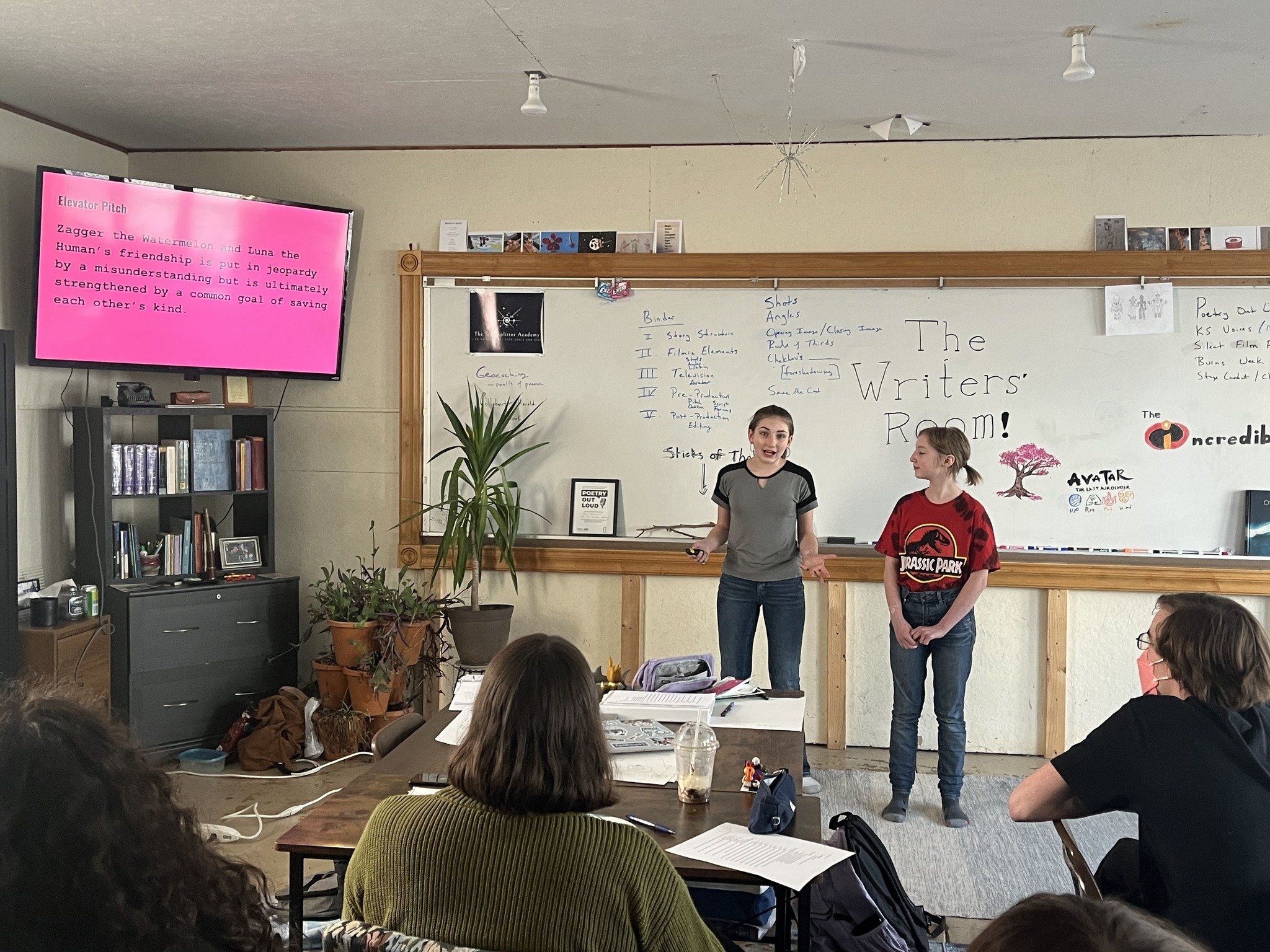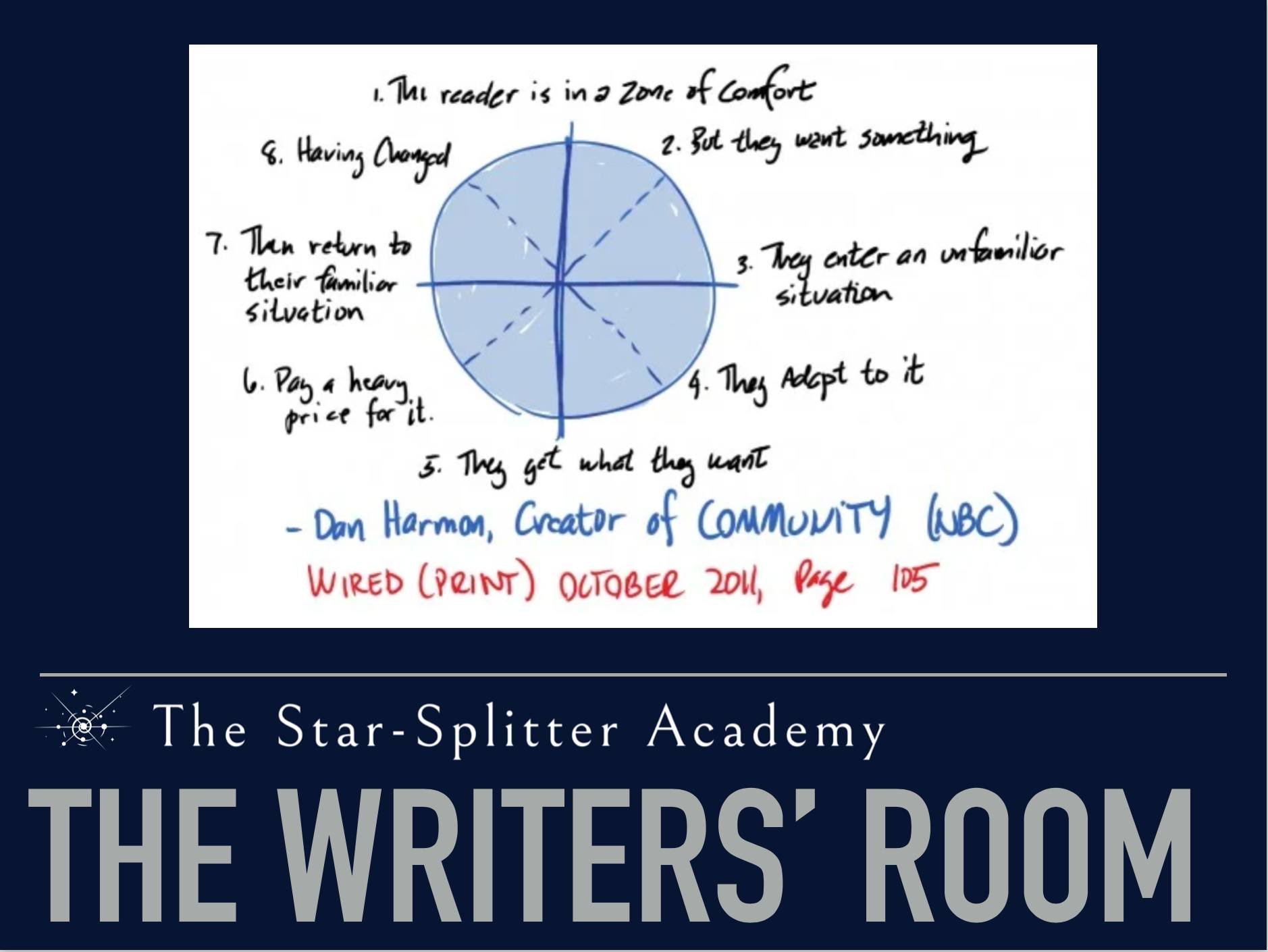The Writers’ Room: Visual Storytelling
In this class, we dove into writing and visual storytelling. Student teams pitched, scripted, filmed, and edited short films. The class culminated in a celebration of their work at the first annual Stardance Film Festival, during which we screened each film and held a talkback with each team, in which they answered audience questions about the making of their work. Students were also presented with awards, keyed to their individual achievements in areas such as cinematography, directing, prop design, editing, and many others.
The class was co-taught by Madi Coleman, a junior at Reed College in Portland, Oregon, who has been part of filmmaking teams that have advanced to the Top Ten Showcase at the Tallgrass Film Festival's 24-hour film race.
In addition to learning a host of technical skills, including how to use editing software, students learned how to organize ideas, how to plan and manage the logistics of making a movie, and exercised the arts of collaboration, teamwork, and public speaking.
We studied storytelling structures (including Joseph Campbell's monomyth/hero's journey, Dan Harmon's story circle [based on Campbell's work] and Blake Snyder’s “Save the Cat” story blueprint).
We investigated how such structures, as well as other filmic elements, are exemplified in TV shows and films, as well as within great works of literature, from The Iliad and The Aeneid to A Christmas Carol and "The Call of the Wild."
Along the way, the Star-Splitters practiced their writing skills in a number of ways: crafting scripts for their short films, creating and presenting pitches for their films (pitches that adhered to a three-point essay form), and writing short stories that followed the hero's journey structure.
The structure of the class mimicked the process of making a TV show or movie: After each team's pitch was green-lit, the students wrote their scripts, upon which they received notes from the studio execs (Madi Coleman and Mr. Coleman). The resulting revisions were printed on blue paper, the standard for shooting drafts. The films then went into production, with students serving in various roles for their classmates' films, including script supervisor, director of photography, and boom operator. The teams then edited and scored their works, then presented them at our first annual Stardance Film Festival.
I want to home in on one moment of the class (among many others), as it illustrates an essential aspect of a Star-Splitter education:
We began the class with a look at the opening eight minutes of The Incredibles. Then, after learning an array of shots, camera angles, and framing options available in cinema, as well as how the choices within those elements influence rhythm, tone, and meaning, we watched those eight minutes again. It was a true pleasure to watch these bright Star-Splitters watch a movie they love with new eyes, alive to the filmmakers' craft, the deep network of technical moves that contributes to the film's power. With all of our freeze-framing and excited conversations, the eight-minute scene spanned forty minutes.
The above is a similar process by which we've learned, over the years, to understand and better evaluate The Canterbury Tales or Macbeth or a scientific study or a Supreme Court case or a system of logic gates: we are learning how the smallest parts work, then slowing down to see how those details relate to one another and to the meaning and value of the work as a whole.
In this way, underneath all that we are learning as Star-Splitters, we are learning how to learn, and learning how to be closer readers of reality.
Our deep dive into writing and filmmaking culminated in the first annual Stardance Film Festival. Student filmmaking teams walked the red carpet, screened their five-minute movies for an audience of special guests, and took part in Q and A sessions. Madi then presented awards to members of the teams.
On Thursday, as part of our deep-dive into visual storytelling, The Writers' Room, The Star-Splitters learned from Madi Coleman how to create complex characters through the use of conflicting character qualities; how to structure a narrative using the story circle structure found within stories from Gilgamesh to The Incredibles; how to create compelling dialogue; how filmic elements such as shot types and camera angles are utilized to create rhythm, tone, and meaning; and how scripts are translated to the screen. Madi applied these concepts to The Incredibles and to the pilot of Avatar: The Last Airbender.
Then Madi led the Star-Splitters in a table read of Avatar's pilot script, so that they could see how those elements are conveyed in the text.
On Friday, the Star-Splitters formed teams that developed pitches for original five-minute movies that incorporate the elements of visual storytelling that they'd learned from Madi on the previous two days: the creation of complex characters through competing characteristics, the use of the Dan Harmon story circle to structure their narratives, and the intentional use of filmic elements to help create tone, rhythm, and meaning (Dutch angles, low angles, first frame / last frame interaction, etc.) The teams created their pitches in Google slides, then delivered them to the class (and to Madi and Mr. Coleman, who were portraying studio executives of the Star-Splitter streaming service). Students not only exercised their composition skills (the pitch comprised a disguised three-point essay) but also gained further experience in public speaking. Everyone did a phenomenal job in all areas of the work--all projects were green-lit, allowing them to advance to the next stage of development: the writing of the first drafts of their scripts, which happened on Monday!
Then Madi led the Star-Splitters in a table read of Avatar's pilot script, so that they could see how those elements are conveyed in the text.
Oliver played Zuko!
The Star-Splitters dressed in the colors of various benders!
After the table read, we watched the pilot episode, freeze-framing often to discuss how what we'd learned is evident in the pilot. Here, Chessie is demonstrating how a certain shot has been framed using the rule of thirds
After each team's pitch was green-lit, the students wrote their scripts, upon which they received notes from the studio execs (Madi Coleman and Mr. Coleman). The resulting revisions were printed on blue paper, the standard for shooting drafts. The films then went into production, with students serving in various roles for their classmates' films, including script supervisor, director of photography, and boom operator.
Our deep dive into writing and filmmaking culminated in the first annual Stardance Film Festival. Student filmmaking teams walked the red carpet, screened their five-minute movies for an audience of special guests, and took part in Q and A sessions. Madi then presented awards to members of the teams.
Student Films
These films were created during The Writers' Room, the Star-Splitter Academy's deep-dive into filmmaking, taught by Madi Coleman, and were shown at the school's inaugural Stardance Film Festival. In the three-week class, students brainstormed, pitched, wrote, revised, filmed, and edited five-minute movies.



























